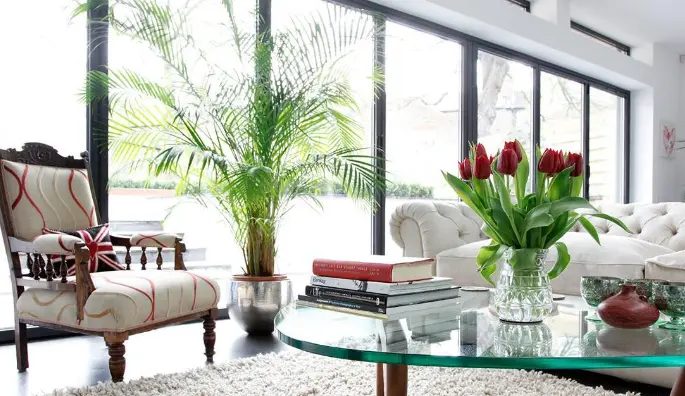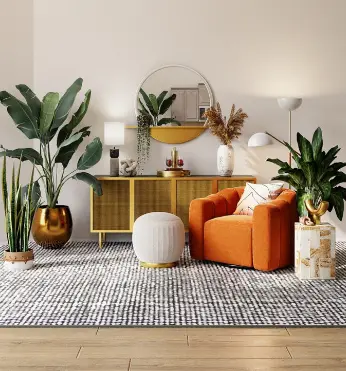What comes to mind when the term “sustainable interior design” is used?
Recycled wood, simple decor, bamboo furniture, and moss-covered walls?
Yes, environmentally friendly interior design may integrate sustainable aesthetics, but it can also include anything.
If keeping things simple and organised is your thing, your room matches the minimalist mould.
But you may also choose to decorate it with bright colours, tonnes of items, and lavish parts of soft furnishings.
Interior design that is sustainable goes beyond style and organisation. It concerns the motivations and processes behind each thing we bring into our homes as well as how we handle them once there.
Sustainable living has taken on critical importance for many people in the modern world. People are looking for methods to incorporate eco-friendly practises into their daily life as environmental worries continue to increase. In order to create places that are not only visually beautiful but also ecologically responsible, homeowners are increasingly embracing environment friendly design concepts.
These eco-friendly interior design ideas can help you freshen up your place in an ethical manner whether you’re moving soon or simply feel the need to change things up.
We’ll go over some fundamental ideas for eco-friendly interior design and easy actions you can take, such where to find home furnishings with a purpose.
Grab your mood board and let’s get started if you’re ready to decorate.
What is Sustainable Home Decor?
A gift that keeps on giving, sustainable living becomes more enjoyable the more you practise it. Sustainable home design focuses on utilizing more natural, biodegradable materials to beautify your house while yet being environmentally responsible. As a result, you leave a smaller carbon footprint while also protecting the environment from the trash, toxins, and gas emissions that may result from using non-sustainable décor.
The goal of sustainable interior design is to create a look for your house that satisfies your requirements now while conserving resources for future generations. An eco-friendly interior is crucial for the following reasons, among others:
- It lessens adverse environmental effects.
- Health benefits of eco-friendly interior design
- This design aesthetic might lower your water and power costs.
- Materials employed in this design aesthetic are reasonably priced.
- Sustainable interior design encourages recycling while reducing waste.
11 Sustainable Home Decor Ideas for Your House
#1 Eco-Friendly Wallpapers

Eco-friendly wallpapers let you avoid the dangerous chemicals that come with synthetic adhesives and wallpaper while still giving your area a new, fresh look. Wallpapers produced conventionally include a lot of volatile organic compounds (VOCs), which are man-made substances used in the production of paint and medicines. Inhaling these substances might make you feel sick and irritate your eyes, nose, and throat.
As an alternative, as they are formed from the bark of the cork oak, natural cork wallpapers are a fantastic choice. Making the switch to non-toxic materials like cotton or grass cloth is excellent for the environment as well as your and your family’s health.
#2 Put indoor plants all throughout your home.
It’s safe to claim that this is the greatest and most economical home or workplace design option! Additionally, you might be surprised to learn that growing indoor plants has a tonne of advantages. Your productivity goes up, your attention span gets simpler, and your stress and anxiety levels go down.
Utilizing plants as décor is the greatest eco-friendly, sustainable interior design method. They make excellent substitutes for the majority of decor items. Additionally, a touch of greenery may improve any situation, and plants complement every home design theme. Choose succulents if there is little natural light in your home. Go green, then!
#3 Use Natural Fragrances
You may create a wonderful scent in your area without using the typical air fresheners in a number of different methods. In addition to being dangerous, they also contain VOCs and over 100 compounds. It’s not too difficult to create your own smells using essential oils and other readily available components. DIY air fresheners are currently a thing. Candles made of soy or palm wax are excellent substitutes.

The importance of aroma in home decor cannot be understated. Who wouldn’t want their house to have a lovely, fresh scent? Therefore, long-lasting artificial room fresheners are frequently chosen by consumers. These air fresheners have hazardous substances in them. As a result, use natural scents like flowers and essential oils. Fresh flowers in a water-filled vase will provide a gentle, pleasant floral aroma that is non-toxic. To create a soothing and peaceful atmosphere, you may also use environmentally safe aromatic candles.
#4 Organic Cotton Bed Sheets Set
Bedsheets may be changed as often as you’d want, and they make a strong fashion statement. Since they are not only more ecologically produced but also very soft and comfy to sleep on, we advise choosing sets of natural organic cotton bed sheets.

#5 Go with Minimal Designs
You have to eliminate the clutter if you want an eco-friendly home! A minimalist design aesthetic is not only in style right now, but it’s also an excellent way to save waste. Additionally, this aesthetic is gorgeous and works well for small flats.
#6 Roofing and flooring without toxins
Eco-friendly home décor ideas for eco-conscious interior design include eco-flooring and eco-roofing. They are produced using harsh, environmentally hazardous chemicals. Interior designers are moving towards natural design goods in light of this.
Modern and bright decors often use bamboo, cork, glass tiles, polished concrete, linoleum, reclaimed hardwood, and wool rugs. In addition to clay roofing tiles, sustainable roofing materials include green roofs, solar roofs, wood shake roofs, and metal roofs.
These sturdy, long-lasting, and environmentally friendly roofing and flooring materials go with any interior decorating concept or colour palette.
#7 Choose classic styles rather than following passing fads
You develop a sense of style through time. A person’s personality may be shown in their chosen style. Styles frequently become classic. On the other hand, fashions change along with lives that move quickly. If you are thinking about sustainability, the secret to keeping on top of your game is to avoid following trends. Yes, many current trends encourage sustainability, but not all will be attractive in the long run. A successful fusion of sustainability and style is uncommon, but once achieved, it last forever.
When decorating your first house, think about selecting patterns, concepts, and colour schemes that will last. For instance, pastels, earthy tones, and neutral hues are wonderfully simple to work with because they seldom clash with other decor elements or one another.
#8 Rugs that are real
“Real rugs” are rugs fashioned from vibrant or natural materials. Rugs composed of synthetic or semi-synthetic materials are widely available on the market nowadays. A natural rug made of hemp, organic cotton, wool, bamboo, jute, or another natural material should be substituted for one made of these materials if you currently have one. Natural resources and labour used to make rugs from ethical sources are also part of sustainable living.
#9 Put in Energy-Efficient Lighting
The right lighting can completely transform a room. Luckily, one of the easiest and least expensive ways to promote sustainability is through lighting design. Therefore, choose energy-efficient fixtures and maximise natural light.
Where feasible, eco interior design combines smart glass, bigger windows, and skylights. Additionally, it favours light colour schemes that need less artificial lighting. The finest artificial lighting options are LEDs or composite fluorescent bulbs.
#10 Water-saving fixtures
Small adjustments may undoubtedly make a significant difference. In fact, you may reduce your water consumption by 70% by adding water-saving shower heads and faucets. This is a low-cost environmental change that might definitely lower your monthly water expenditures. This proves that environmentally friendly interior design changes don’t necessarily have to be expensive.
#11 Change Your Perspective on Decor
The area most likely to experience regular upgrades and modifications is décor. Products that are depending on seasons and trends are therefore more prone to waste and excessive use. It’s time to change the way we think about ornamental items in light of this.
Plants and other living things are always environmentally beneficial and suitable for every season. Alternately, make use of what you already have by rearranging items or exploring different uses. For instance, a little mirror works well as both a wall decoration and a fancy tray.
Conclusion
Sustainable interior design is a quick and inexpensive way to live in harmony with the environment. Some products are pricey because of the manufacturing process involved, but they are one-time purchases that are safer than cheap, hazardous, unsustainable alternatives. From this point on, we advise switching to eco-friendly home furnishings, and the suggestions stated above will be quite beneficial.



[…] Sustainable, Budget-Friendly, Eco-Friendly Decor Ideas. Read Now […]